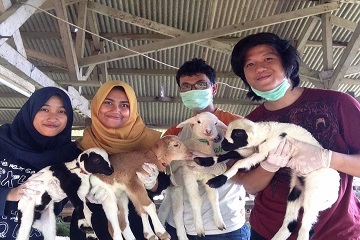A Group of Students of IPB Identified the levels of Biodiversity of Indonesia indigenous coprophilous fungi of pastures, in West Java

Indonesia has the second highest level of biodiversity after Brazil. One of them is donated by fungi. Indonesian fungi make up 25.5% of the world's mushroom diversity, which is approximately 12,000 of the 47,000 species. The percentage is said to be low considering that Indonesia's geographical position is very suitable for growing fungi. It is due to the fact that we lack of research on the biodiversity of native fungus Indonesia.
Christian Tristianto, student of Bogor Agricultural University (IPB), as chairman together with his team consists of Bagus Eko Nugroho, Mustika Rini, and Puspitasari Anggiani, under the sponsorships of Program Kreatifitas Mahasiswa, Penelitian (PKM-P Student Creativity Program for Research) designed the research program to study the diversity of coprophilous fungi in the pasture. This study aims to identify the levels of biodiversity of Indonesia indigenous coprophilous fungi in pastures, in West Java and its anthelmintic potential in sheep.
Truffle fungi have various methods to spread and reproduce. One of which is coprophilous fungi that grows on the substrate of animal feces. Coprophilous fungi (dung-loving fungi) are a type of saprobic fungi that grow on animal dung. The hardy spores of coprophilous species are unwittingly consumed by herbivores from vegetation, and are excreted along with the plant matter. The fungi then flourish in the feces, before releasing their spores to the surrounding area. Coprophilous fungi play an important role in the decomposition and mineralization of herbivore dung. In addition, coprophilous fungi have many potentials such as arachidonic acid (ARA), natural nematicides, antibiotic metabolites, and cellulase enzymes.
Herbivore feces do not only contain arachidonic acid spores, but also worm eggs, bacteria, protozoa, and other microfungi. It is a symbotic feature of the herbivorous digestive tract. Positive interaction when the host is benefited, negative when the host is disadvantaged, and neutral if the host is not disadvantaged or disadvantaged. Interactions can also occur between symbionts. One of them is the interaction between coprophilous fungi against worms. If the interaction is negative, the worm eggs in the feces are reduced.
"Many species of parasites only cause problems when their numbers are particularly high or in certain localities at particular times of year. Worm infections can lead to decreased production in the form of weight loss, stunted growth, and decreased milk production and endurance in livestock," he explained. Medicines to treat worms are sometimes called anthelmintics. Anthelmintics or antihelminthics are a group of antiparasitic drugs that expel parasitic worms (helminths) and other internal parasites from the body by either stunning or killing them and without causing significant damage to the host. There are allegations that coprophilous fungi would perform as practical biological control agents against animal parasitic nematodes.
The most common health problem of domestic sheep, especially young lambs, is internal parasites (worms). Sheep are more susceptible to internal parasites than most other types of farm livestock for several reasons. Particularly in West Java, Indonesia, almost 100% of its sheep are exposed to worms. In the past, farmers relied heavily on anti-parasitic drugs called "anthelmintics" to control internal parasites in their flocks. But the long-time use and in some cases misuse of these drugs has resulted in parasites that have become increasingly resistant to anthelmintics. "We are worried with residues of the anthelmintics in the animals’ edible tissue. We have to prevent our health carefully, " said Christian.
The experiments were carried out by the team used the feces taken from sheep in the IPB Jonggol Animal Education and Research Unit, and the grazing area around Jatitujuh Sugar Factory, Kuningan. Samples were taken to the Laboratory of Division of Animal Function and Behaviour of Department of Biology, IPB. The feces is prepared and incubated for a worm eggs counting. The worm eggs in the feces are calculated to determine the level of worm infection (FEC, Faecal Egg Count). Classified as mild infection if the number of worm eggs in sheep ranges from 0-499 eggs / gram; Medium 500-2000 eggs / gram; And weighing over 2000 eggs / gram (Tarazona 1986). The team is getting medium infected sheep, with the number of eggs reaching 1500 pieces.
To identify and isolate ovicidal fungi in the feces of sheep, a total of feces samples were taken from those locations and kept captive in 5 containers wrapped with cotton to keep it moist. Then they were filled with 3 corpuscles and they incubated to grow the fungi for observation.
"We are still at the stage of fungal identification. I am facing a problem in identification of fungus under microscope. This is because of the difficulty to get complete structure of fungus and not all the fungus that we grow has a complete structure, "said Christian students of IPB majoring in Biology.
According to him, the fungus are said to have anthelmintic potential if they have good negative correlation. For example, if fungus A taken from two different sheep faecal samples 1 and 2, and the number of worm eggs in a sample of then were analysed. Sample with fewer the number of eggs showed that such fungus has the anhelmintic potential. (Wied)



